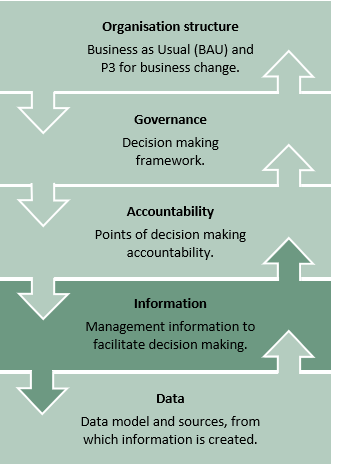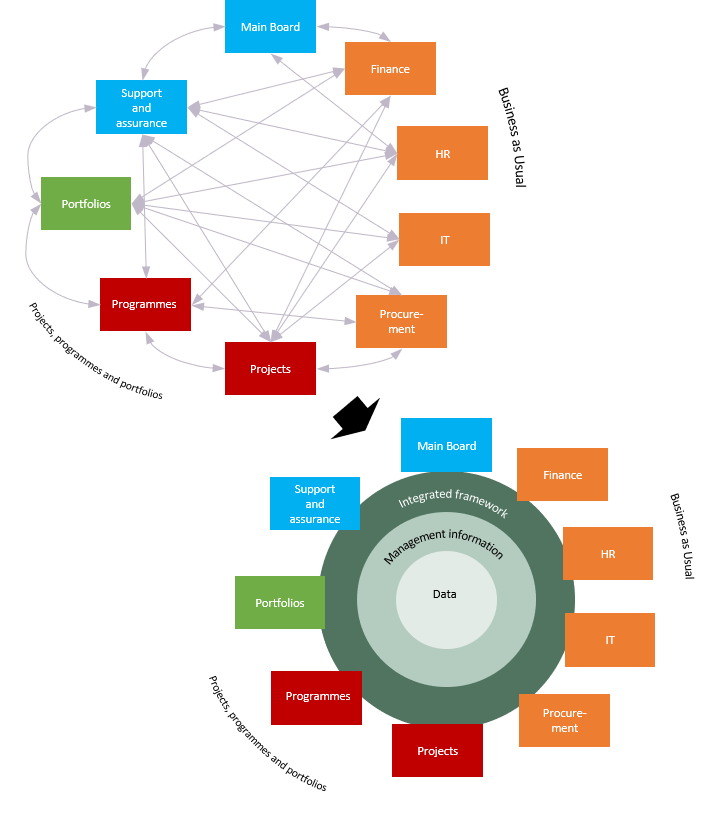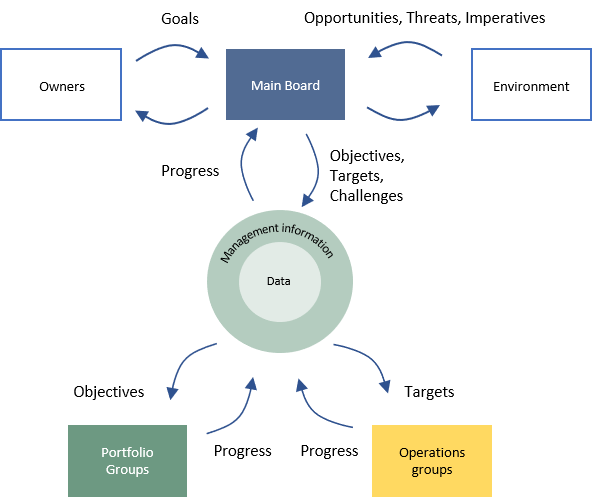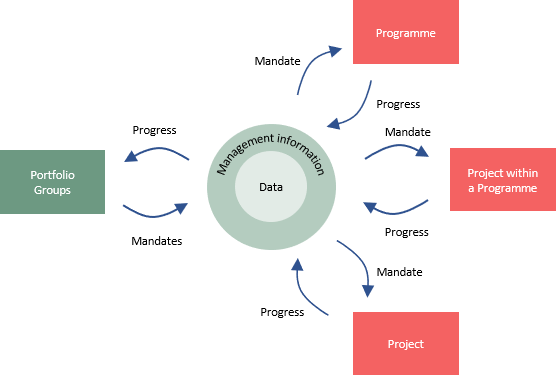 Good governance is only possible with accurate and timely information that supports decisions and actions.
Good governance is only possible with accurate and timely information that supports decisions and actions.
Each Governance Node has a defined ‘agenda’ that typically contains cyclical performance reviews, escalations and forecasting. This enables decisions to be taken at key moments.
Each agenda item is deconstructed into information definitions that support the agenda steps.
These are based on a mixture of good practice from respected practitioners and consultants, suggestions from fellow professionals and tool vendors. They should be used as a starting point for an organisation to adapt the BIG model.
Information Flows
At each Governance Node some sources of information are within the control of the accountable person and some are controlled by partner departments and organisations.
The worst-case scenario is that each Governance Node creates and sources the information it needs in isolation, causing a network of point to point connections, emails, spreadsheets, slides, meeting minutes etc.
The BIG approach avoids having to duplicate information in this way. It promotes information sharing rather than information exchange. However, just storing data in the same place does not ensure the flow of information for operational and governance needs. To achieve this, it is necessary to create alerts that information has become available or that information is expected for a particular stage in the governance cycle.

It may be necessary to configure solutions that route information from point to point and prompt for their timely transfer. All this can be made much simpler by providing a central repository of shared information.
Gathering information as and when needed from all sources can be very time consuming, unreliable and expensive. It is therefore common for businesses to coordinate around standard cycles and publish integrated information on progress, cost and projections at planned moments in time.
This is because it is easier to make assurance and decision support resources available in peaks and troughs. It does not have to institute a bureaucracy and can provide sufficient alignment to avoid parochial business unit data boundaries and their related delays.
Connecting tools using standardised data classifications enables the management of ‘golden threads’ of information though the organisation. The specific MI then delivered to or engaged by each ‘user’ can be tailored – but based on the same core data.
The governance level in BIG focuses on nodes and roles rather than individuals. The relationships between Governance Nodes can be described in terms of the information they share. For example:
Main Board
The Main Board is concerned with directing business level strategy and using performance data to track performance and forecast future progress. It focuses on the OTIGs and responds with OTCs.

A Main Board dashboard can show all OTIGs and how they map to OTCs. This promotes continuing visibility of which objectives and targets have been assigned and how they are progressing. It also becomes possible to track challenges, which will be worked on within the Main Board until it is appropriate to hand over as an objective or target.
Objectives and targets may be broken down into enabling roadmaps, expected key results, benefit expectations and cost/timing expectations. These are shared from their source systems into the core data model. The Main Board may need to sanction responses and authorise outline plans for enabling programmes and projects. The information layer will map responses to enable further decisions and actions.
Portfolio Direction Group
Depending on life cycle design, the Portfolio Direction Group (PDG) hands over a portfolio mandate to the Portfolio Progress Group (PPG). This enables decomposition into various roadmap items and prioritisation. Within the portfolio, programme and project managers and sponsors are appointed.
Programmes will also be decomposed into interdependent projects that each deliver a clear distinct output. Each entity may have a complex structure, but typically has links to documents, role definitions, milestones, risks, issues, actions, decisions, dependencies and resource requirements. Items may be related to other items (e.g. an issue may arise from a risk that happens, an action may result from a decision, a decision may emerge from a meeting etc.)

Programmes and projects
Programme and project life cycles connect their management processes with decision points and periodic performance reviews. Typically, a programme or project receives a mandate to which it responds with a brief that secures resources and funding. It then develops a full business case that can be evaluated, prioritised and approved.
In addition to the transmission of information down the chain, there needs to be a return of information to allow performance to be evaluated; forecasts to be understood; decisions made and actions set.
Feedback will include information about developing outputs from projects and benefit realisation from programmes and operational teams. There may be metrics that need collection and analysis to enable overall status and accomplishment to be measured.
The detail of what information is required will be a local matter (using information management plans, tolerances etc.) and determined by the life cycles and methods being used. Having a core P3M data model enables the business to maintain an effective information flow while avoiding expensive point to point integrations.
Management teams
There will be ongoing interactions between portfolios, programmes, projects and operational management teams. Protocols will be established for allocation, provision and distribution of funds and resources provided by BAU to portfolios, programmes and projects.
Typically, there are many-to-many relationships between operational teams and projects and programmes. An individual operational team may supply resources and funding to multiple projects and a programme may have business change effects on multiple areas of BAU.
The BIG model facilitates collation and consolidation of information for each Governance Node in the network.
Thank you to the Core P3M Data Club for providing this page.





